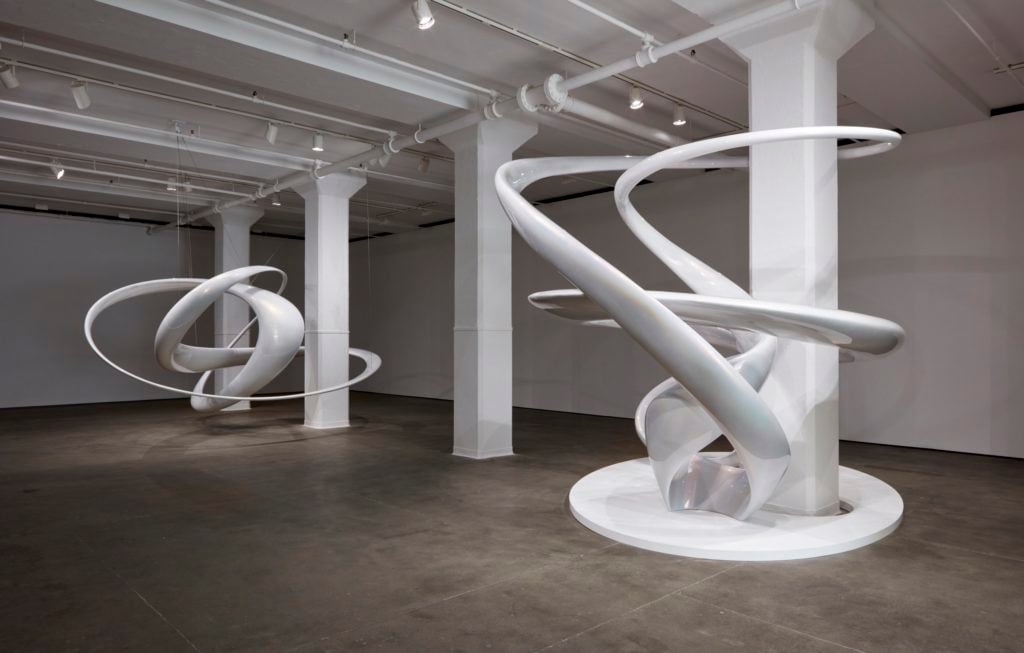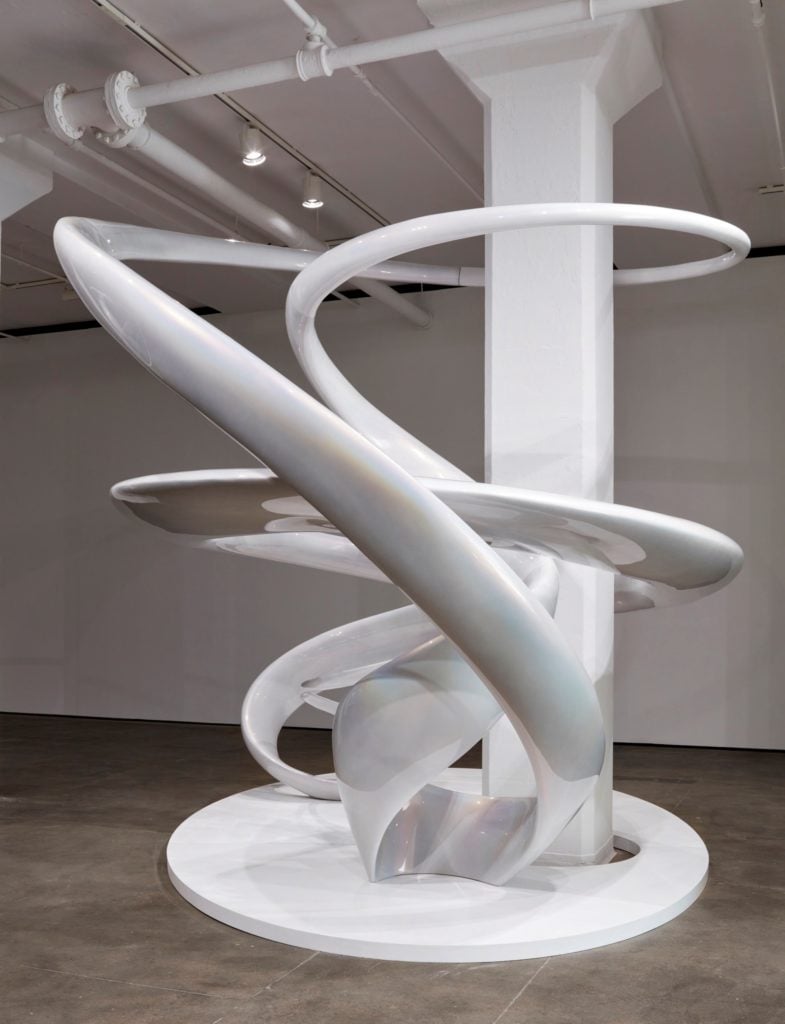On View
How Mariko Mori Used Robots and Ancient Metalwork Techniques to Create Her Latest Sculpture
What happens when robots start making our art?

What happens when robots start making our art?

Tim Schneider

Everyone has heard by now that the robots are coming for our jobs. But the real question begged by that alarmist statement is this: Does “coming for our jobs” mean “coming to replace us,” or “coming to help us do what we could never do without high-tech help”?
One fascinating answer to this dilemma is on view now at Sean Kelly Gallery in Chelsea. It takes the form of a serpentine colossus of painted steel by the Japanese artist Mariko Mori. The work owes its existence to a synergy of human creativity, advanced software, and ancient craftsmanship. In short, the robots (broadly speaking) were a necessary, but not sufficient, condition to make the work possible.
Like the rest of “Invisible Dimension,” Mori’s surrounding solo exhibition, Cycloid V (2017–18) arose from her continued interest in using sculpture to visualize imperceptible scientific concepts and phenomena, such as superstring theory and particle physics. But the work also offers revealing insight into how a certain kind of artist works today: with an international network of fabricators and assistants harnessing technology that, in some cases, didn’t exist even a decade ago.
That’s where next-generation art, architecture, and design studio UAP comes in. After a chance meeting at the gallery last January, Mori began discussing how the combined studio and workshop—which has previously collaborated with artists including Idris Kahn, Leo Villareal, and Ai Weiwei—might help develop work for her upcoming show.
Although she had initially proposed a more modest version of Cycloid V, UAP’s prototype so excited Mori that she quickly decided she’d like to scale the piece up to the maximum size that Kelly’s space could accommodate. Its monumentality also speaks to the second novel ambition sparked by the early model: Mori now wanted the work to be installable outdoors.
The artist’s new vision generated significant challenges. As Jamie Perrow, the senior principal of UAP’s art and design division, explained to artnet News, “The entire approach to the fabrication had to alter.” Mori would have to work with a structural engineer so that Cycloid V could be properly stamped and certified for placement in an exterior environment. She would also have to accept that the sculpture would be fabricated in sections due to constraints on shipping size, material strength, and time. As soon as Mori signed on for all of the above, it was time for UAP’s team to get to work.

Mariko Mori’s
Cycloid V (2017-2018). Copyright Mariko Mori. Photography: Jason Wyche, New York. Courtesy: Sean Kelly, New York.
The first problem to solve centered on the fabrication technique. To be viable outdoors, Cycloid V would have to be made in steel. But according to Perrow, the form as Mori had designed it could not be cast. If it were, the arcing, cantilevered stretches of the sculpture would be far too heavy and would likely crack at the very least, if not “kind of just snap.”
This limitation meant that the work would have to be made not using cutting-edge science, but rather a method that is “basically as old as mankind”: the same one craftsmen had first used to create shields or jewelry ages ago. Perrow describes the technique as an “artisanal craft approach to panel-beating the metal.” At bottom, the fabrication relied on skilled metalworkers wielding hammers to body-form steel over anvils.
The process is exceedingly meticulous and, in an age of automated manufacturing, exceedingly rare. Perrow explained that the United States and Australia, where UAP was founded before expanding to New York and Shanghai, used to employ plenty of capable panel-beaters—primarily in auto shops, where they frequently used the technique to repair fenders or perform other bodywork. But then it became cheaper to simply replace an entire bumper or door, and those jobs dried up.
Fortunately, though, UAP could still execute Cycloid V at their workshop in Shanghai, where the skill hasn’t yet been lost to time and technological ease. There, a team of craftsmen spent untold hours shaping roughly one-foot by one-foot sheets of stainless steel by sight, laying them over a skeleton of stainless and mild steel to check for fit, then reshaping them as necessary until each section was flawless. Eventually, the perfectly formed segments could be welded together atop the structure, then primed and spray-coated with a subtly iridescent white that Mori custom-developed with Italian paint specialist Lechler.
However, before the Shanghai team could launch into their virtuoso display of old-school craftsmanship, UAP needed to welcome in the robots.
“Building this 3-D space manually, without scripting, would have taken far too long,” Perrow says. At the same time, typical 3-D-modeling software would not be robust enough for Mori’s purposes. “You can create a 3-D form pretty easily in a variety of programs,” he explains, “but to create a 3-D form that an engineer can then use in their modeling [and calculation software] is a completely different story.” To insure the work’s structural stability for a possible public home, then, UAP’s team had to develop “highly innovative computer modeling techniques”—techniques that he estimates were not available even ten years ago.
The end result was both a technological hybrid and a feat of interdisciplinary cooperation. Sean Kelly explains that Mori does not obsess over technical details when conceiving her works. “The idea for the movement of the piece, the thickness or thinness of the piece, and the dynamism of the piece is very inherent to her way of thinking about the work. Then it’s, ‘Well, can we find the right people to make this possible? Can you interpret this into reality?’”
The version of Cycloid V realized through UAP measures roughly 12 feet high by 16 feet wide by 11 feet deep. Kelly says it is “the largest in this cycle of work and the most ambitious in terms of any gallery installation.” And yet it could not have been done without the human synergy between Mori, UAP, and the gallery.
“In that sense, it’s a very old-fashioned Renaissance collaborative event,” Kelly notes. ”But this is the 21st century, postmodern version of it.” Maybe the robots aren’t all so bad—at least, not when they work for us.
Mariko Mori’s “Invisible Dimension” is on view at Sean Kelly Gallery at 475 10th Avenue in Chelsea from March 23 to April 28.